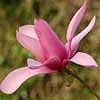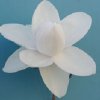| MAGNOLIA
'Big Dude' (M. sprengeri 'Diva' x M. x soulangeana 'Picture') Although completely unrelated, it is reminiscent of M. sargentiana var. robusta, with an upright but spreading growth habit and very large nodding flowers, up to 35cm across, with 9-12 tepals which are fragrant and rose pink outside, white within. |
|
|
|
|
| MAGNOLIA
'Blushing Belle' (M. ‘Yellow Bird’ x M. ‘Caerhays Belle’) This hybrid from Dennis Ledvina (2001) was possibly my “stand-out” discovery of last spring. Aesthetically similar to ‘Caerhays Belle’, but much hardier and with narrower tepals, the large flowers are deep pink with a lighter pink interior. Despite the parentage, there is no trace of yellow. |
|
|
|
|
| MAGNOLIA
'Brenda' This selection from M. acuminata var. subcordata has amazing brilliant golden flowers; they make up for their size deficit (7-8cm) by the intensity of their colour. A slow growing, compact tree. |
|
|
|
|
| MAGNOLIA x
brooklynensis 'Black Beauty'
(M. acuminata x M. liliiflora) This hybrid from the Brooklyn Botanic Garden has very dark purple flowers, which have a contrasting creamy white interior. The upright, weather-resistant flowers are not overly large and it’s late season flowering which makes it a great choice in a harsher site. |
|
|
|
|
 |
MAGNOLIA x
brooklynensis 'Hattie Carthan' (M. x brooklynensis 'Evamaria' x M. x brooklynensis #209) The neat yellow flowers are noticeably highlighted by purple veins ascending from the base of the tepals. As is typical of this group, it is late flowering (at much the same time as the leaves unfurl) thus avoiding the worst of the frosts. Potentially a large tree, and satisfyingly fast growing. |
|
|
|
| MAGNOLIA 'Butterbowl' ([M.‘Yellow Bird’ x M.‘Sundance’] x M.‘Yellow Dance’) A Belgian selection, having small but fleshy, broad-tepalled flowers of a unique orange-yellow colour which retain their shape for a long period. A tidy, handsome small tree. |
|
|
|
|
 |
MAGNOLIA 'Butterflies' (M. acuminata x M. denudata 'Sawada's Cream') This cultivar is protected by Plant Breeders Rights which means you have to have a licence to propagate it. When it was first released, it was considered by many to be the best thing since sliced bread, but to be honest, there are so many other yellow magnolias now that it has been largely superseded. If you don't have the energy to rummage through our collection, drop me an e-mail detailing the type of effect you want and I will make some suggestions. |
|
|
|
 |
MAGNOLIA 'Caerhays Belle'
(M. sargentiana var. robusta x M. sprengeri 'Diva') Large clear pink flowers, like those of M. campbellii which open to huge bowls. Attractive upright and spreading branches. 5m. Will give best results in a favoured part of the country - early flowering, the gorgeous flowers are susceptible to frost damage. |
|
|
|
 |
MAGNOLIA
'Caerhays Surprise' (M. campbellii var. mollicomata x M. liliiflora 'Nigra') From a 1959 cross made at Caerhays Castle, Cornwall, this lovely hybrid produces rosy lavender flowers from bright violet red buds. The outer petals are reflexed, giving the blooms a somewhat star- shaped appearance. 4m |
|
|
|
| NEW | MAGNOLIA campbellii 'Betty Jessel' |
|
|
|
| NEW | MAGNOLIA
campbellii 'Darjeeling' The original tree is in the Darjeeling Botanic Gardens, India. It is often confused with 'Betty Jessel' since the flowers are a dark rose to wine red colour. It forms a strong upright tree with a rounded crown to 8m. One of the deepest coloured campbellii selections. |
|
|
|
| MAGNOLIA
campbellii 'Kew's Surprise' This wonderful seedling of 'Charles Raffill' produces large flowers which are crimson rose outside and white inside. Their cup and saucer shape is typical of the var. mollicomata parentage. Free flowering to 6m. |
|
|
|
|
 |
MAGNOLIA
campbellii subsp. mollicomata 'Lanarth' M. campbellii subsp. mollicomata 'Lanarth' Absolutely one of the classic magnolias, it was raised from seed sent from Yunnan Province in China in 1924 by the renowned plant hunter George Forrest. The cup and saucer shaped flowers, so typical of the species, are a unique shade, variously described as “cyclamen pink”, “vintage port” or “lilac-purple-red”. |
|
|
|
 |
MAGNOLIA
campbellii 'Sir Harold Hillier' The aristocrat of all our Magnolias - if you have the space and the foresight to plant for your children, then this is the Magnolia for you. This selected white form of the classic early flowering species is truly beautiful in favoured locations. |
|
|
|
| MAGNOLIA
'Candy Cane' Nine erect tepals in three whorls, make up the flowers of this Gresham hybrid of unknown parentage, where each whorl has a distinct coloration. The outer whorl is also somewhat reduced. Outer tepals are rose at base fading to white at tip, with a rose stripe running from base to tip. The middle whorl of tepals has similar coloration, but slightly darker. The inner whorl is even deeper rose-purple at the base. |
|
|
|
|
| MAGNOLIA
'Carlos' Another fabulous yellow; an Eisenhut seedling selected by Philippe de Spoelberch. It flowers very late in the spring, just as the leaves are unfurling, thus avoiding the frosts. |
|
|
|
|
 |
MAGNOLIA
'Chameleon' Correctly called M. 'Chang Hua'. This has an upright flower which is almost tulip shaped. Predominantly white, the outside is prettily flushed with pink, particularly at the base and mid-rib. Lightly fragrant too. |
|
|
|
| MAGNOLIA
'Charles Coates' (M. sieboldii x M. tripetala) A superb hybrid between 2 summer flowering species. The creamy white flowers in May-June have distinctive crumpled petals and a conspicuous boss of red stamens in the centre, so typical of the group. Deliciously scented too. |
|
|
|
|
| NEW | MAGNOLIA 'Charming Lady' |
|
|
|
 |
MAGNOLIA
'China Town'
(more
correctly called M. 'Jing Ning') This cultivar has come to Europe from China, but I can't find out its parentage. The flowers are slightly reminiscent of those of M. stellata, being relatively small with multiple narrow tepals, but the plant is much more upright in habit than is typical for M. stellata. Perhaps it's a hybrid, I really don't know. Whatever the case, I like it tremendously. It would make a wonderful small tree for a more confined space becasue it is so well proportioned and elegant. The flowers are almost pure white, with just the tiniest touch of pink at the base. |
|
|
|
| MAGNOLIA 'Columbus'
(M. denudata x M. x veitchii 'Peter Veitch') Potentially a large tree, this Magnolia has a lovely history. Although bred at the US National Arboretum, it was selected by the late John Bond, then Keeper of the Gardens at Windsor. He named it to mark the 500th Anniversary of Columbus' voyage, with oblique reference to the Magnolia's cross Atlantic journey also! It freely produces large cup-shaped white flowers. Our original material was kindly given to us by John Bond from the original plant. |
|
|
|
|
| MAGNOLIA
'Coral Lake' (M. 'Legend’ x M. 'Butterflies’) The large rather upright flowers have 11 tepals and open to 17.5cm across. A blend of pinks shades to vertical yellow stripes on the outside, all paler within. Although it flowers late in the season, they usually open before the leaves expand. It is however, very hardy and frost tolerant. Relatively vigorous, but distinctly upright habit. |
|
|
|
|
| NEW | MAGNOLIA 'Crescendo' |
|
|
|
| MAGNOLIA
'Crystal Chalice' (M. x soulangeana ‘Lennei’ x M. sprengeri ‘Diva’) The white flowers of this Maurice Foster selection have a very elegant form, opening into a shapely bowl. |
|
|
|
|
| MAGNOLIA
'Cup Cake' (M. x soulangeana ‘Lennei Alba’ x M. x veitchii) Another Gresham hybrid; this one has fragrant creamy white flowers 30cm across, each highlighted by an inner pink disc and a prominent boss of stamens. |
|
|
|
|
| MAGNOLIA
cylindrica 'Bjuv' A medium sized tree to 9m, M. cylindrica is noted particularly for the seed pods which open to reveal shining orange seeds. The white flowers in April-May are actually fragrant at night. There has been much confusion over nomenclature of various seedlings distributed over the years, so it is good to have a recognised cultivar to ensure the integrity of the species. |
|